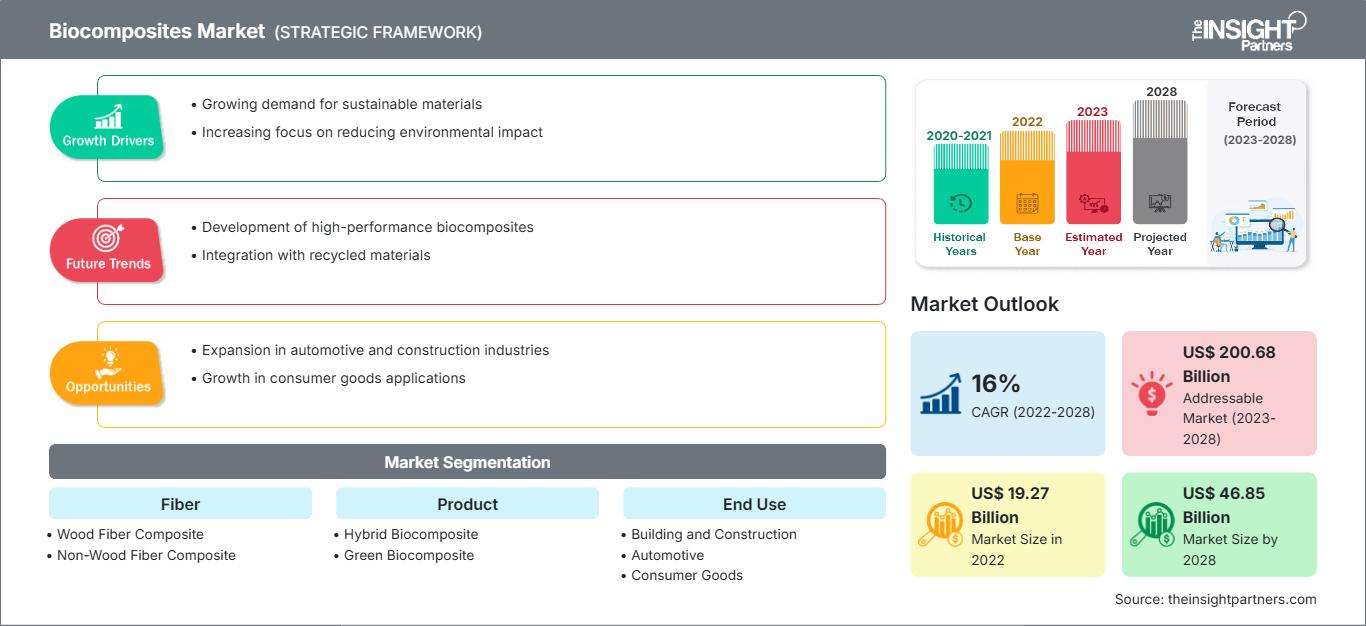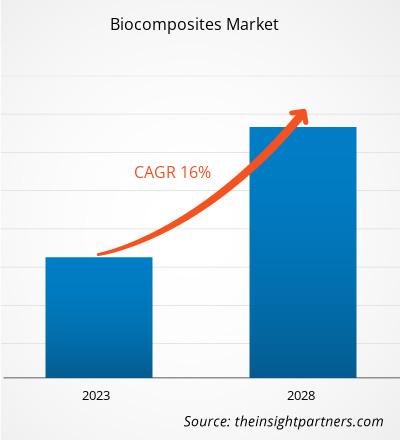[Forschungsbericht] Der Markt für Biokomposite soll von 19.268,62 Millionen US-Dollar im Jahr 2022 auf 46.851,39 Millionen US-Dollar im Jahr 2028 wachsen; von 2022 bis 2028 wird mit einer durchschnittlichen jährlichen Wachstumsrate (CAGR) von 16 % gerechnet.
MARKTANALYSE
Biokomposite sind Materialien, die durch die Verstärkung von Naturfasern und einer Matrix (Harz) hergestellt werden. Das Interesse an Biokompositen wächst in den Endverbraucherbranchen rasant, beispielsweise in der Grundlagenforschung, der Verpackungsindustrie, im Bauwesen, im Militärbereich, in der Luft- und Raumfahrt, im Eisenbahnwaggonbau und in der Automobilindustrie. Grund dafür sind die vielen potenziellen Vorteile wie einfache Verfügbarkeit, hohe spezifische Festigkeit, geringes Gewicht, biologische Abbaubarkeit, Recyclingfähigkeit, geringere Kosten und Erneuerbarkeit. Biokomposite werden in der Automobilindustrie häufig zur Herstellung von Innenraumverkleidungen eingesetzt. Da Biokomposite umweltfreundlich sind, ersetzen sie Polymerkomposite in zahlreichen Anwendungen zu einem hohen Preis.
WACHSTUMSTREIBER UND HERAUSFORDERUNGEN
Die zunehmende Verwendung nachhaltiger Baumaterialien hat das Wachstum des Biokompositmarktes gefördert. Die Bauindustrie ist aufgrund der wachsenden Bevölkerung in städtischen Gebieten einer der am stärksten von der rasanten Urbanisierung betroffenen Sektoren. Diese Urbanisierung macht die Industrie zum erstaunlichsten Verbraucher von Materialien, die größtenteils aus nicht erneuerbaren Ressourcen bestehen. Laut dem Bericht der Global Alliance for Building and Construction ist der Bausektor einer der umweltschädlichsten. Der Studie zufolge ist der Bausektor für 39 % der in die Umwelt freigesetzten Kohlendioxid-Emissionen, für 36 % des weltweiten Energieverbrauchs und für 50 % der Rohstoffgewinnung verantwortlich. Die Emissionen sind hauptsächlich für den Klimawandel verantwortlich und erhöhen die Erdtemperatur. Herkömmliche Baumaterialien sind sehr ressourcen- und energieintensiv. Daher wächst die Besorgnis und das Bewusstsein für die Gefahren herkömmlicher Baumaterialien, die sowohl soziale als auch ökologische Auswirkungen haben. Um diesen Problemen zu begegnen, werden in der Bauindustrie neue Materialien und Technologien entwickelt. Biokomposite sind nachhaltige Baumaterialien, die dazu beitragen, nicht erneuerbare Abfälle zu vermeiden, den Rohstoffverbrauch zu senken und den Verbrauch fossiler Brennstoffe zu reduzieren. Das Interesse an Biokompositen in der Bauindustrie steigt weltweit, da diese Materialien aus erneuerbaren, recycelbaren und biologisch abbaubaren Quellen hergestellt werden und ein breites Anwendungsspektrum als strukturelle und nicht-strukturelle Bauelemente bieten. Naturfaserverbundwerkstoffe weisen jedoch einige Nachteile auf, wie z. B. eine schlechte Faser-Matrix-Grenzflächenhaftung, schlechte Benetzbarkeit und Wasseraufnahme. Diese Herausforderungen beeinträchtigen die Festigkeit und Leistung der Endprodukte. Aufgrund ihrer hydrophilen Natur neigen Biokomposite dazu, Wasser aus der unmittelbaren Umgebung aufzunehmen, wodurch sie aufquellen. All diese Faktoren werden voraussichtlich das Wachstum des Biokompositmarktes im Prognosezeitraum hemmen.
Passen Sie diesen Bericht Ihren Anforderungen an
Sie erhalten kostenlos Anpassungen an jedem Bericht, einschließlich Teilen dieses Berichts oder einer Analyse auf Länderebene, eines Excel-Datenpakets sowie tolle Angebote und Rabatte für Start-ups und Universitäten.
Markt für Biokomposite: Strategische Einblicke

-
Holen Sie sich die wichtigsten Markttrends aus diesem Bericht.Dieses KOSTENLOSE Beispiel umfasst Datenanalysen, die von Markttrends bis hin zu Schätzungen und Prognosen reichen.
SEGMENTIERUNG UND UMFANG DES BERICHTS
Die „Globale Marktanalyse für Biokomposite bis 2028“ ist eine spezialisierte und detaillierte Studie mit Schwerpunkt auf den globalen Markttrends und Wachstumschancen für Biokomposite. Der Bericht bietet einen Überblick über den globalen Markt für Biokomposite mit detaillierter Marktsegmentierung nach Faser, Produkt, Endanwendung und Geografie. Der globale Markt für Biokomposite verzeichnete in der jüngeren Vergangenheit ein starkes Wachstum und wird diesen Trend im Prognosezeitraum voraussichtlich fortsetzen. Der Bericht liefert wichtige Statistiken zum weltweiten Verbrauch von Biokompositen sowie zur Nachfrage in wichtigen Regionen und Ländern. Darüber hinaus bietet der Bericht eine qualitative Bewertung verschiedener Faktoren, die die Marktleistung für Biokomposite in wichtigen Regionen und Ländern beeinflussen. Der Bericht enthält auch eine umfassende Analyse der führenden Akteure auf dem Biokompositmarkt und ihrer wichtigsten strategischen Entwicklungen. Darüber hinaus sind mehrere Analysen der Marktdynamik enthalten, um die wichtigsten Antriebsfaktoren, Markttrends und lukrativen Marktchancen für Biokomposite zu identifizieren, die wiederum bei der Identifizierung der wichtigsten Einnahmequellen helfen.
Darüber hinaus bieten die Ökosystemanalyse und die Fünf-Kräfte-Analyse von Porter eine 360-Grad-Sicht auf den globalen Biokompositmarkt, die zum Verständnis der gesamten Lieferkette und der verschiedenen Faktoren beiträgt, die das Marktwachstum beeinflussen.
SEGMENTANALYSE
Der globale Biokompositmarkt ist nach Faser, Produkt und Endverwendung segmentiert. Basierend auf der Faser wird der Biokompositmarkt in Holzfaserverbundwerkstoffe und Nicht-Holzfaserverbundwerkstoffe unterteilt. Basierend auf dem Produkt wird der Markt in Hybrid-Biokomposite und grüne Biokomposite klassifiziert. Auf der Grundlage der Endverwendung wird der Markt in Bauwesen, Automobilindustrie, Konsumgüter und Sonstiges unterteilt.
Basierend auf der Faser machte das Segment Holzfaserverbundwerkstoffe einen bedeutenden Marktanteil bei Biokompositen aus. Der Hauptnachteil von Holzfaserverbundwerkstoffen ist ihre Feuchtigkeitsempfindlichkeit. Dank zunehmender Forschung und Entwicklung produzieren die Hersteller jedoch Holzfaserkomponenten mit höherer Feuchtigkeitsbeständigkeit, größerer Steifigkeit und einem niedrigeren Wärmeausdehnungskoeffizienten. Auf der Grundlage des Produkts führen Hybridverbundwerkstoffe den Markt für Bioverbundwerkstoffe mit dem größten Marktanteil an. Basierend auf der Endnutzung dominiert das Segment Bau und Konstruktion den Markt für Bioverbundwerkstoffe. Bioverbundwerkstoffe werden im Bauwesen für Rahmen, Wände und Wandplatten, Fensterrahmen, Türen, Fußböden, dekorative Verkleidungen, Trennwände und Deckenplatten verwendet. Die Verwendung von Bioverbundwerkstoffen für temporäre und anpassbare Gebäudekomponenten reduziert den Deponieabfall, wenn die Innenausstattung innerhalb der Struktur geändert wird.
REGIONALE ANALYSE
Der Bericht bietet einen detaillierten Überblick über den globalen Markt für Bioverbundwerkstoffe im Hinblick auf fünf Hauptregionen, nämlich Nordamerika, Europa, Asien-Pazifik (APAC), Naher Osten und Afrika (MEA) sowie Süd- und Mittelamerika. Der asiatisch-pazifische Raum hatte einen erheblichen Anteil am Markt und wurde im Jahr 2022 auf über 9.300 Millionen US-Dollar geschätzt. Der asiatisch-pazifische Raum umfasst mehrere Entwicklungs- und Industrieländer wie China, Indien, Japan, Südkorea und Australien. Der entscheidende Faktor für das Wachstum ist die steigende Nachfrage aus den Bereichen Bau und Transport für die Endverbrauchsindustrie. Die hohe Nachfrage nach Biokompositen ist vor allem in China, Japan, Indien und Südkorea zu beobachten. Auch der Anstieg der ausländischen Direktinvestitionen (FDI) in den Sektoren Transport und Infrastruktur dürfte die Nachfrage nach Biokompositen in den nächsten Jahren ankurbeln. Auch in Europa wird aufgrund der steigenden staatlichen Ausgaben für den Infrastrukturausbau ein beträchtliches Wachstum im Wert von etwa 11.000 Millionen US-Dollar im Jahr 2028 erwartet. Darüber hinaus werden Biokomposite in Nordamerika häufig im Wohnungs- und Gewerbebau, bei Konsumgütern und in der Automobilbranche eingesetzt. Dies hat lukrative Möglichkeiten auf dem Markt für Biokomposite geschaffen. Der Markt für Bioverbundwerkstoffe in Nordamerika wird im Prognosezeitraum voraussichtlich um durchschnittlich 15,0 % jährlich wachsen.
BRANCHENENTWICKLUNGEN UND ZUKÜNFTIGE CHANCEN
Partnerschaften, Übernahmen und die Einführung neuer Produkte erwiesen sich als die wichtigsten Strategien der Akteure auf dem globalen Markt für Bioverbundwerkstoffe.
- Im Mai 2022 plante Arkema die Einführung seiner neuen Lösung für recycelbare und immer effizientere Verbundwerkstoffe.
- Im März 2021 kündigte Fiberon die Einführung einer Wildwood-Verbundverkleidung an, die die unvergleichliche Schönheit und Wärme von Holz mit der Haltbarkeit leistungsstarker, wartungsarmer Materialien kombiniert.
Bioverbundwerkstoffe
Regionale Einblicke in den BiokompositmarktDie Analysten von The Insight Partners haben die regionalen Trends und Faktoren, die den Biokompositmarkt im Prognosezeitraum beeinflussen, ausführlich erläutert. In diesem Abschnitt werden auch die Marktsegmente und die geografische Lage in Nordamerika, Europa, dem asiatisch-pazifischen Raum, dem Nahen Osten und Afrika sowie Süd- und Mittelamerika erörtert.
Umfang des Marktberichts zu Biokompositen
| Berichtsattribut | Einzelheiten |
|---|---|
| Marktgröße in 2022 | US$ 19.27 Billion |
| Marktgröße nach 2028 | US$ 46.85 Billion |
| Globale CAGR (2022 - 2028) | 16% |
| Historische Daten | 2020-2021 |
| Prognosezeitraum | 2023-2028 |
| Abgedeckte Segmente |
By Faser
|
| Abgedeckte Regionen und Länder |
Nordamerika
|
| Marktführer und wichtige Unternehmensprofile |
|
Dichte der Marktteilnehmer für Biokomposite: Auswirkungen auf die Geschäftsdynamik verstehen
Der Markt für Biokomposite wächst rasant, angetrieben durch die steigende Endverbrauchernachfrage aufgrund von Faktoren wie sich entwickelnden Verbraucherpräferenzen, technologischem Fortschritt und einem stärkeren Bewusstsein für die Produktvorteile. Mit steigender Nachfrage erweitern Unternehmen ihr Angebot, entwickeln Innovationen, um den Verbraucherbedürfnissen gerecht zu werden, und nutzen neue Trends, was das Marktwachstum weiter ankurbelt.

- Holen Sie sich die Markt für Biokomposite Übersicht der wichtigsten Akteure
AUSWIRKUNGEN VON COVID/AUSWIRKUNGEN DES GEOPOLITISCHEN SZENARIOS/AUSWIRKUNGEN DER REZESSION
Lockdowns, Reisebeschränkungen und Geschäftsschließungen aufgrund der COVID-19-Pandemie wirkten sich negativ auf Volkswirtschaften und Industrien in verschiedenen Ländern Nordamerikas, Europas, im asiatisch-pazifischen Raum (APAC), Süd- und Mittelamerikas sowie im Nahen Osten und Afrika (MEA) aus. Die Krise störte globale Lieferketten, Fertigungsaktivitäten, Lieferpläne sowie den Verkauf lebenswichtiger und nicht lebenswichtiger Produkte. Verschiedene Unternehmen kündigten mögliche Verzögerungen bei Produktlieferungen und einen Einbruch der zukünftigen Verkäufe ihrer Produkte im Jahr 2020 an. Darüber hinaus zwangen die von verschiedenen Regierungen in Europa, im asiatisch-pazifischen Raum und in Nordamerika verhängten internationalen Reiseverbote mehrere Unternehmen dazu, ihre Kooperations- und Partnerschaftspläne aufzugeben. All diese Faktoren behinderten die Chemie- und Materialindustrie im Jahr 2020 und Anfang 2021 und bremste damit das Wachstum verschiedener mit dieser Branche verbundener Märkte, einschließlich des Marktes für Biokomposite.
Vor dem Ausbruch von COVID-19 wurde der Markt für Biokomposite hauptsächlich durch die steigende Nachfrage aus der Automobil- und Bauindustrie angetrieben. Im Jahr 2020 mussten jedoch verschiedene Branchen ihre Aktivitäten aufgrund von Störungen der Wertschöpfungsketten aufgrund der Schließung nationaler und internationaler Grenzen drosseln. Die COVID-19-Pandemie unterbrach die Lieferkette wichtiger Rohstoffe und störte die Herstellungsprozesse aufgrund von Beschränkungen, die von Regierungsbehörden in verschiedenen Ländern verhängt wurden. Die Volkswirtschaften belebten jedoch ihre Aktivitäten wieder. Die zuvor verschobenen Bauprojekte wurden wieder aufgenommen, was den Akteuren des Biokompositmarktes eine weitere Gelegenheit bot, zur Normalität zurückzukehren.
WETTBEWERBSLANDSCHAFT UND WICHTIGE UNTERNEHMEN
Zu den wichtigsten Akteuren auf dem Markt für Biokomposite gehören TTS; Lingrove; Bcomp Ltd; UPM; Flexform Technologies; Tecnaro GmbH; Fiberon; Arkema; Trex Company, Inc.; und HempFlax Group BV unter anderem.
- Historische Analyse (2 Jahre), Basisjahr, Prognose (7 Jahre) mit CAGR
- PEST- und SWOT-Analyse
- Marktgröße Wert/Volumen – Global, Regional, Land
- Branchen- und Wettbewerbslandschaft
- Excel-Datensatz
Aktuelle Berichte
Verwandte Berichte
Erfahrungsberichte
Grund zum Kauf
- Fundierte Entscheidungsfindung
- Marktdynamik verstehen
- Wettbewerbsanalyse
- Kundeneinblicke
- Marktprognosen
- Risikominimierung
- Strategische Planung
- Investitionsbegründung
- Identifizierung neuer Märkte
- Verbesserung von Marketingstrategien
- Steigerung der Betriebseffizienz
- Anpassung an regulatorische Trends






















 Kostenlose Probe anfordern für - Markt für Biokomposite
Kostenlose Probe anfordern für - Markt für Biokomposite